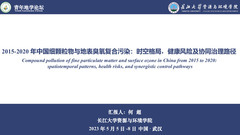报告详情
Compound pollution of fine particulate matter and surface ozone in China from 2015 to 2020: spatiotemporal patterns, health risks and synergistic control pathways
编号:3646
访问权限:私有
更新:2023-04-16 17:49:43 浏览:607次
口头报告
摘要
The increasingly pronounced compound pollution issue of fine particulate matter (PM2.5) and surface ozone (O3) concentrations in China has exacerbated the risk of human morbidity and death. In this study, the spatial and temporal characteristics, health risks and synergistic control pathways of PM2.5–O3 compound pollution in 365 cities in China from 2015 to 2020 were investigated based on spatial statistical analysis, integrated risk index model and spatial correlation analysis. The results show that: The strict air pollution control measures lead to a sustained decrease in PM2.5 leading polluted cities and a sustained increase in clean cities during the study period. However, there is a trend of increasing (2015–2017) and then decreasing (2018–2020) in cities with compound PM2.5 and O3 pollution because of changes in volatile organic compounds (VOCs) and NOx caused by human activities. According to the exposure analysis method, the population exposed to PM2.5 dominated polluted cities declined by 471 million from 2015 to 2020; in contrast, the population living in clean cities increased by 460 million. With the intensification of PM2.5–O3 compound pollution in China, the exposure to PM2.5–O3 compound pollution urban population increases sharply from 349 million in 2015 to 622.5 million in 2018, an increase of more than 40%; as air quality improves after 2017, the population exposed to PM2.5–O3 compound pollution gradually decreases, falling to the equivalent level in 2015 by 2020. Meanwhile, the population health risks attributed to PM2.5 pollution were reduced, whereas the population health risks attributed to PM2.5–O3 compound pollution were aggravated. From a spatial perspective, PM2.5–O3 compound pollution and health risk exacerbation regions were concentrated in northern and eastern China. In addition, we found that PM2.5 and O3 concentrations have significant synergistic trends,which are consistent with VOC and NOx in spatial distribution, which is conducive to the synergistic management of PM2.5 and O3 in China.
关键词
PM2.5¬–O3 compound pollution,Temporal spatial patterns,Integrated Health Risks,synergistic control pathways,China
报告人

何超
长江大学稿件作者
全部评论
重要日期
-
会议日期
05月05日
2023
至05月08日
2023
-
03月31日 2023
初稿截稿日期
-
05月25日 2023
注册截止日期
主办单位
青年地学论坛理事会
中国科学院青年创新促进会地学分会
中国科学院青年创新促进会地学分会
承办单位
武汉大学
中国科学院精密测量科学与技术创新研究院
中国地质大学(武汉)
中国科学院精密测量科学与技术创新研究院
中国地质大学(武汉)



发表评论